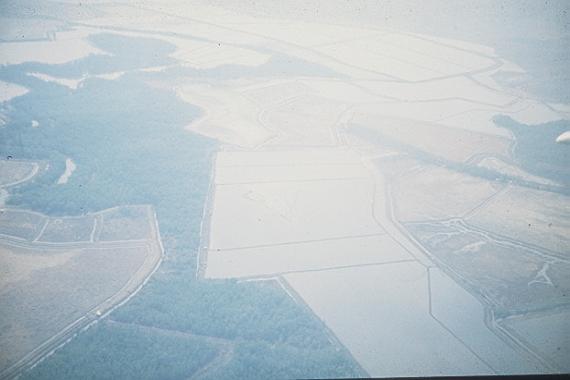| Extensive grow-out systems | |
|
Extensive pond culture was historically the first to evolve, and is the least sophisticated. Extensive ponds are much like natural ecosystems with respect to nutrient inputs, nutrient cycling, species diversity, oxygen dynamics, and level of human intervention. Extensive ponds are also still the most common. Although their yield per ha is small, they require little attention or operational cost; and the owners realize continued net income year after year. In some cases, individual extensive ponds have been in operation for centuries. Extensive farms have little effect on the environment (Fast, 1992). Extensive shrimp farming (low-density) is conducted in the tropics, in low-lying impoundments along bays and tidal rivers, often in conjunction with herbivorous fish. Impoundments range in size from a few hectares to over a hundred hectares. When local waters are known to have high densities of young shrimp, the farmer opens the gates, impounds the wild shrimp and then grows them to market size. Fishermen also capture wild postlarvae and sell them to extensive farmers for stocking. Overall, however, stocking densities are quite low, not over 25,000 postlarvae per hectare (Rosenberry, 1998). In their least complicated form, extensive ponds are built by constructing dikes around a low lying land area within the intertidal zone. Water exchange is accomplished through tidal action. Mangrove areas in estuaries have been prime candidates for such pond construction since they typically have gentle slopes, adequate tidal range, abundant wild shrimp seed, and land ownership vested with government. Such land was usually easy to use and inexpensive. Until very recently, there was little concern about conversion of mangrove forests into aquaculture ponds with resultant loss of other potential or known resources. Resource managers are now generally concerned about loss of mangroves. This awareness, and resultant regulations now make it difficult to build in these locations. Almost no new extensive shrimp farms being constructed too large (Fast, 1992).
Shrimp feed on naturally occurring organisms which may be encouraged with organic or chemical fertilizer. Construction and operating costs are low and so are yields. Cast-nets and bamboo traps produce harvests of 50 to 500 kilograms (head-on) per hectare per year. Production costs range from $1.00 to $3.00 per kilogram of live shrimp. Extensive shrimp farming is applied in Vietnam, Indonesia and Ecuador (Rosenberry, 1998). |
|
 Mangrove areas are not without problems for shrimp culture. Much of
the soil in these areas, especially in Asia, is acidic. Exposure of
this soil during dike construction and between crops can lead to
acidification of pond soils and waters. The pond dikes are
particularly vulnerable since their upper portion is always exposed to
air and acidification. Following long dry periods, rain can wash
lethal amounts of acid into the ponds. If properly managed over time,
these problems decrease due to sedimentation, leaching and loss of
acid from dikes. Reconstruction of these ponds, however, can expose
acid soil and renew the problem (
Mangrove areas are not without problems for shrimp culture. Much of
the soil in these areas, especially in Asia, is acidic. Exposure of
this soil during dike construction and between crops can lead to
acidification of pond soils and waters. The pond dikes are
particularly vulnerable since their upper portion is always exposed to
air and acidification. Following long dry periods, rain can wash
lethal amounts of acid into the ponds. If properly managed over time,
these problems decrease due to sedimentation, leaching and loss of
acid from dikes. Reconstruction of these ponds, however, can expose
acid soil and renew the problem (